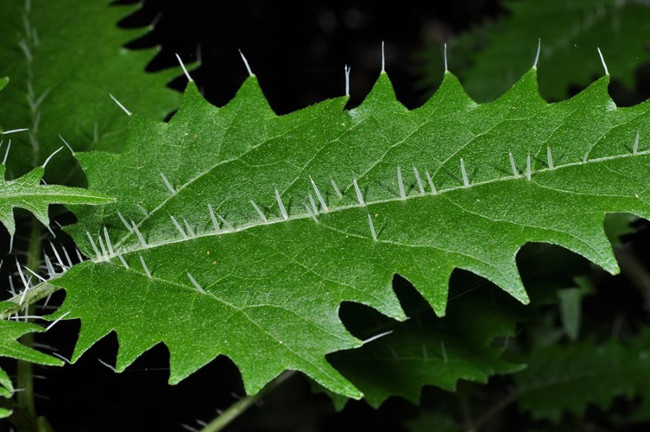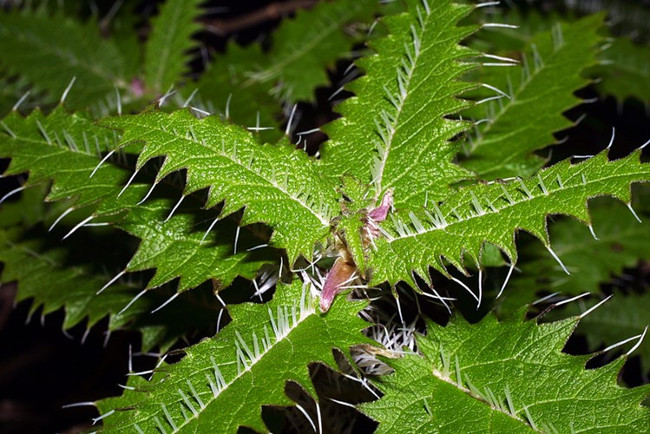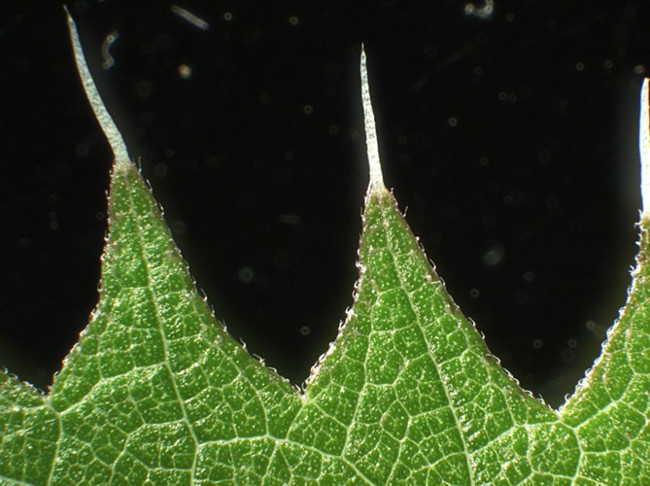Fear of poisonous plants that corrode humans
Nature is extremely rich and diverse. Besides the "gentle" plants, there are many extremely poisonous plants, capable of killing humans. Urtica ferox, a nettle distributed mainly in New Zealand is one of the world's most poisonous plants.

Urtica ferox, also known as Ongaonga in Maori, is sometimes called straight nettle or Taraonga, Taraongaonga or Okaoka.Unlike other herbaceous plants in Urtica, Urtica ferox is a large woody shrub

The tree is about 3 meters tall with long spines containing poison.They are sharp weapons that many animals and humans die.

The toxin in thorns of nettles Urtica ferox is triffydin (or tryfydin).This toxin contains histamine, serotonin and acetylcholine, powerful stimulants to the parasympathetic nervous system.

When hit by Urtica ferox spikes, the victim suffered a very painful reaction from a rash, itching, and dermatitis.Only 5 hemp stalks Urtica ferox are enough to kill a hamster.If there is a lot of prickly Urtica ferox stabbing, the victim may suffer from motor paralysis, hypotension, convulsions, blurred vision and confusion.

Urtica ferox nettles, the ultimate weapon of this plant, contain nerve agents that are lethal and also highly corrosive even when transient contact.

Even the victims are promptly cured, they are still capable of degenerating the nervous system, polyneuropathy.

In New Zealand, Urtica ferox nettles live in subtropical and temperate areas, Urtica ferox is very popular in the North Island but is limited to the South.In the South it is often found on the West Coast and on the Banks Peninsula.

Although nettle Urtica ferox is actually a highly toxic shrub, it also plays an important part in the development of red admiral butterflies (Vanessa gonerilla), a local butterfly.Nettle Urtica ferox leaves are favorite foods and provide protection for red admiral butterfly larvae.

In addition, nettle Urtica ferox is also used in medicine, treating diseases such as eczema, venereal, gonorrhea.Even this plant is used as a Māori food but must be specially prepared.
You should read it
- Air New Zealand hacked, customer information is at risk of falling into the hands of hackers
- Birds have poison, can kill people just by touching the feathers
- Why can't YouTube automatically block the video of New Zealand shootings that have been re-up rampant?
- Beat losing, poisonous snakes rolled to death to deceive birds
- 11 species of lethal poisonous plants that we should avoid
- How can eating poisonous mushrooms cause death?
- 11 beautiful flowers contain deadly poisonous drama
- 9 unique snakes in the world
May be interested
- Birds have poison, can kill people just by touching the feathers
 it sounds unbelievable but really exists poisonous birds. the first case of poisonous birds recorded in the world is due to researcher jack dumbacher accidentally discovered in the early 1990s.
it sounds unbelievable but really exists poisonous birds. the first case of poisonous birds recorded in the world is due to researcher jack dumbacher accidentally discovered in the early 1990s. - Plants feel pain when they are eaten and have a defense mechanism against it
 don't think plants are inanimate, they have intelligence. scientists have discovered that vegetables and plants sense when they are eaten by enemies and of course they do not like this.
don't think plants are inanimate, they have intelligence. scientists have discovered that vegetables and plants sense when they are eaten by enemies and of course they do not like this. - Robots are identical to humans that are almost indistinguishable, causing confusion and fear
 fred made the customers of a bar in london to be satisfied. they are almost indistinguishable fred is a robot or a human when talking to it.
fred made the customers of a bar in london to be satisfied. they are almost indistinguishable fred is a robot or a human when talking to it. - 12 types of ornamental plants clean the indoor air
 some ornamental plants not only help decorate your house but also absorb chemicals that pollute the air to bring a healthy living space to your family.
some ornamental plants not only help decorate your house but also absorb chemicals that pollute the air to bring a healthy living space to your family. - Beat losing, poisonous snakes rolled to death to deceive birds
 in a fierce battle, both poisonous snakes use dead planes to avoid the cypress bird's attack but fail.
in a fierce battle, both poisonous snakes use dead planes to avoid the cypress bird's attack but fail. - Configuring play Layer Of Fear on computer
 you can choose to configure it to a high or low graphics level to experience the layer of fear 2 in this article.
you can choose to configure it to a high or low graphics level to experience the layer of fear 2 in this article. - Use a hot water tree with a child lock to ensure safety
 for families with young children, it is advisable to choose hot and cold water plants with hot spouts to ensure the safest. 5 hot water plants with child lock are the best products for families.
for families with young children, it is advisable to choose hot and cold water plants with hot spouts to ensure the safest. 5 hot water plants with child lock are the best products for families. - How can eating poisonous mushrooms cause death?
 there are about 10,000 species of mushrooms but only a small fraction of them are poisonous. the danger is: not all poisonous mushrooms are recognizable by their bright colors.
there are about 10,000 species of mushrooms but only a small fraction of them are poisonous. the danger is: not all poisonous mushrooms are recognizable by their bright colors. - Cause and remedy error on hot and cold water plants
 if the hot and cold water plants have water leaks, water reflux, water that is not hot / cold, loud noise, please consult immediately how to fix the water heater error below.
if the hot and cold water plants have water leaks, water reflux, water that is not hot / cold, loud noise, please consult immediately how to fix the water heater error below. - Not only people but even animals do not dare to array to the unique tree species on this planet
 manchineel tree is also called hippomane mancinella, dubbed the dead tree by carrying in its terrible toxin type that people must attach warning labels should stand away from trees 6m, not eat and avoid to plastic of this plant stick to the skin.
manchineel tree is also called hippomane mancinella, dubbed the dead tree by carrying in its terrible toxin type that people must attach warning labels should stand away from trees 6m, not eat and avoid to plastic of this plant stick to the skin.










 The truth about the 'she' elephants in the elephant world
The truth about the 'she' elephants in the elephant world Strange creatures hide deep in the ocean floor
Strange creatures hide deep in the ocean floor Hurricane No. 3 is approaching level 14 in Vietnam
Hurricane No. 3 is approaching level 14 in Vietnam Marvel at animals with superhuman abilities that look exactly like Pokemon
Marvel at animals with superhuman abilities that look exactly like Pokemon Startling the monstrous creatures with faces from ... hell
Startling the monstrous creatures with faces from ... hell The reason why hummingbirds never had an accident
The reason why hummingbirds never had an accident